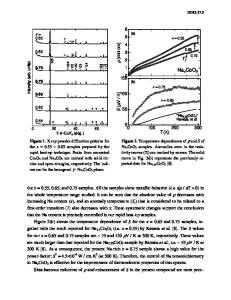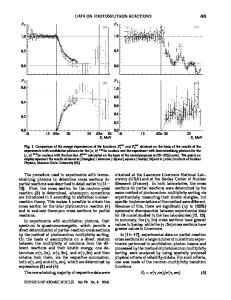133 Cs and 23 Na NMR Studies of Cs 8 Na x Ge 136 Clathrates
- PDF / 148,035 Bytes
- 6 Pages / 612 x 792 pts (letter) Page_size
- 40 Downloads / 314 Views
133
Cs and 23Na NMR Studies of Cs8NaxGe136 Clathrates
R.F. Marzke1, G. S. Nolas2, and J. Gryko3 1
Dept. of Physics, Arizona State University, Tempe, AZ 85287 Dept. of Physics, University of South Florida, Tampa, FL 33620 3 Dept. of Physical & Earth Sci., Jacksonville State Univ., Jacksonville, AL 36265 2
ABSTRACT We report 133Cs and 23Na spectra of Cs8NaxGe136 clathrates. Fully loaded Cs8Na16Ge136 shows only ionic signals from both Cs and Na nuclei. In contrast to the Cs8Na16Si136 clathrate, germanium Cs8Na16Ge136 clathrate shows no large Knight or paramagnetic shifts. However, when sodium is removed from Cs8Na16Ge136, the resulting Cs8Ge136 clathrate shows a very large shift in the 133Cs NMR spectrum. INTRODUCTION Group IV clathrates were first synthesized over thirty years ago by Cros et al [1] by a controlled decomposition of alkali metal silicides and germanides. Early X-ray studies [1] showed that these materials form a cubic lattice consisting of tetrahedrally bonded group IV atoms arranged in an open type framework structure. Two types of clathrates were identified in those studies. Type I clathrates form a simple cubic lattice with 46 atoms per unit cell. Type II clathrates form a FCC lattice with 136 atoms in the unit cell. In both clathrates the framework atoms are arranged into larger and smaller cages. In type I there are six 24 atom cages stacked in a 3-dimensional network of mutually perpendicular channels, and two 20 atom cages fill the remaining space. In type II there are eight large 28 atom cages and sixteen small 20 atom cages, with the larger cages forming a tetrahedral network. The smaller and larger cages could be partially or completely occupied by atoms of alkali and alkaline earth metals. Furthermore, group III metals, such as aluminum or gallium could replace some of group IV atoms in the framework. Many very interesting properties of these materials arise from the large number of combinations of occupancies of clathrate cages and different substitutions in the framework. For example, barium-filled type I clathrates are superconductors [2], whereas a Sr8Ga16Ge30 clathrate has very low thermal conductivity [3]. Type I clathrates are promising materials for thermoelectric applications, and their transport properties have been extensively measured [4]. Guest metal atoms can be completely removed from type II clathrates, resulting in a wide band gap silicon semiconductor [5]. These and other properties resulted in numerous investigations of clathrates in the last several years. A partial list of references to recent studies of clathrates is given by Nolas et al. [4] and by He et al [6]. A powerful technique for studying the interaction between guest metal atoms and framework atoms is magic angle spinning NMR. The 23Na spectra of fully loaded silicon clathrates, Na8Si46 and Na24Si136, are quite similar, and show two sharp peaks corresponding to sodium atoms in small and large cages. Surprisingly, these peaks are shifted from approx. 1600 ppm to approx. 2000 ppm with respect to the ionic sodi
Data Loading...











